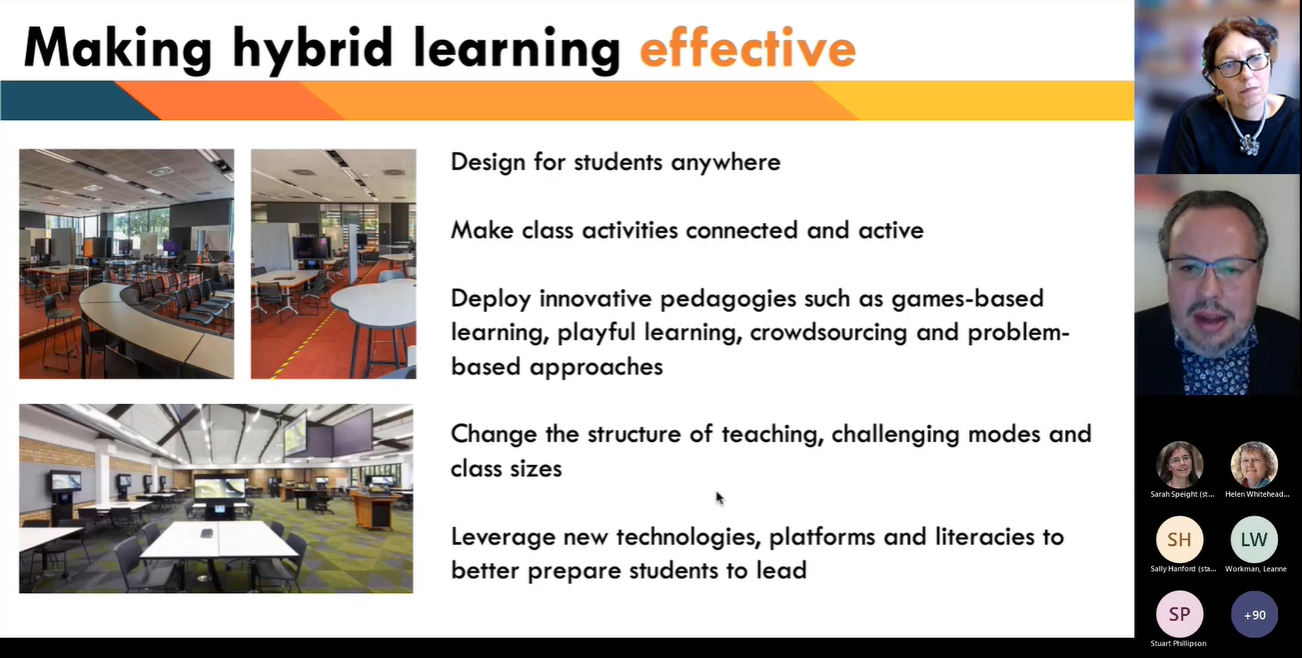
April 11, 2022, by Helen Whitehead
Hybrid Teaching and Learning in HE: a futuristic model or a realistic model for the future? Summary and Reflection
‘Hybrid Teaching and Learning in HE: a futuristic model or a realistic model for the future?’ was a question addressed at a workshop held by the University of Nottingham in early 2022, when universities were ready to turn the pandemic corner. More than 150 participants from around the globe were brought together to share their practice and learn from a community of academic and technical colleagues who had experienced hybrid teaching. Despite the different levels of expertise, the common denominator linking all contributions was the wish to explore the potentials of hybrid teaching and learning to shape the future of Higher Education in ways that might have seemed impossible before the pandemic. In this post we summarise and reflect on the themes and the conference.
Authors: Cecilia Goria and Sally Hanford
Hybrid Teaching and Learning
The term hybrid refers here to the simultaneous teaching of online and in-class students attending the same session. It is distinguished from the popular label ‘hyflex’, to keep the level of flexibility of attendance as an open question, to be addressed by individual institutions based on their own needs.
A unified definition of hybrid teaching remains elusive, but, through practice, literature reviews (Miranda Melcher and Jane Secker, City University, London), the support of communities of practice (Rachelle O’Brien, Durham University), and student feedback (Mark Taylor & Kimberley Sheen, Manchester Metropolitan University) the aim is to identify models that combine face-to-face (F2F) and online teaching in ways that are sustainable, inclusive and pedagogically effective, while meeting the needs of individual institutions.
The event which included keynotes by Peter Bryant (University of Sydney) and Rodrigo Sanchez-Pizani (King’s College London), and contributions from colleagues worldwide, provided a blend of technological and pedagogical insights.
This reflective piece summarises and reflects on the highlights of the event to shape the global conversation about hybrid teaching and learning in which technological and pedagogical themes are addressed in synergy; hybrid requires changes that affect classroom teaching and classroom space equipment. The lesson learnt so far is that effective hybrid requires a robust marriage between pedagogy and technology, in line with the notion of entangled pedagogy (Fawns: 2021) that suggests a cognitive shift from thinking of pedagogy as driving technology or vice versa, to a mutual shaping of pedagogy and technology. This shift relies on dialogue, teamwork and collaboration, as emphasised in Matt Turner’s (University of Birmingham) contribution, normalisation of technology (Dominic Pates, City University, London) and on addressing those hidden gaps (Dominic Lukes, University of Oxford) that commonly affect the way academics embrace new technology-dependent practices.
Introductions and controversies
Professor Sarah Speight, Pro-Vice Chancellor for Education and Student Experience, University of Nottingham, opened the event reminding us that, as students come back to their classrooms, while the efforts made by tutors to ensure the continuation of learning online are highly appreciated, online pedagogies are still perceived as substandard teaching solutions. Hence, the need to be transparent about online pedagogical goals to pre-empt this misconception.

Peter Bryant
On a similar note, Peter Bryant highlighted four reasons why hybrid teaching remains controversial. Firstly, as institutions around the world have invested in building and campuses, hybrid practices question the relationship between education and the space within which it takes place. Secondly, the COVID-induced rapid development of remote teaching challenges rooted assumptions about the embodiment of education. Thirdly, student satisfaction and related feedback reflects a misunderstanding of the values of online practices. Finally, a feeling of nostalgia has emerged, affecting the return to the classroom and ‘snapback’ to pre-pandemic practices.
Design
‘Designing for scale’, Peter Bryant explained, provides opportunities to address these challenges and support the transition of hybrid from necessity to opportunity, capitalising on the view that hybrid teaching is not limited to the delivery of stand-alone sessions, instead it concerns the learning journey as a whole.
Design facilitates the co-presence experience, Dominic Pates (City University, London) explained, and seamlessly integrating technology in the design of hybrid teaching is the ultimate goal for reducing barriers to participation. Similarly, Annelies Raes’ (KU Leuven, Belgium) contribution and underpinning research points once again to the relation between design technology and pedagogical design. KU Leuven’s award-winning rooms for hybrid and remote teaching with multiple screens and integrated audio solutions are conceived to foster presence, maximising participation and ultimately learning, in spite of the physical distance of those attending online.
Hybrid design embeds interaction amongst all participants. Polling and Q&A tools, as demonstrated by Louise Robson (University of Sheffield), activities carried out in shared digital spaces, as illustrated by Jamie Heywood (Anglia Ruskin University), and the use of virtual labs, as described by Steve Murphy (Birmingham City University) serve this purpose by bridging the gap between the virtual and physical spaces, creating at the same time a space agnostic environment (Bryant: n.d.) which foster and facilitate engagement and in which students are able to find a voice.
Support and guidance

Rodrigo Sanchez-Pizani
Alongside design, support and guidance feature highly in the hybrid conversation. Developing mental models, as argued by Dominic Lukes, facilitates the understanding of and the coping with the demands of hybrid teaching. From a different perspective, Rachelle O’Brian’s contribution emphasised the supportive role of crisis-triggered virtual communities as new spaces for sharing and learning from experiences and examples of good practice.
Across the board, institutions testing the hybrid ground have developed guidance for staff, students and technical services, based on piloting equipment, classroom experiences and literature reviews, highlighting again the need for technology and pedagogy to work in synchrony. With this in mind, Rodrigo Sanchez-Pizani emphasised that the technical challenges of and solutions for hybrid must not be ignored.
Technical challenges
In terms of physical spaces, there are local factors to be considered. Addition of new hardware must be compatible with existing audio-visual installations. What works in one location may not be appropriate elsewhere.
Equipment that is not permanently installed in a room poses practical challenges that should not be underestimated, and so permanent room installations are generally preferred.
Similarly, the acoustic properties of the teaching rooms must be considered; hence audio-visual experts should be included in any multi-skilled team that makes decisions about enhancing physical teaching spaces.
The location of the kit in the room is significant. KU Leuven had located screens at the back of some rooms and at the front of others (akin to an additional row of students) and Rodrigo Sanchez-Pizani talked about a carefully positioned screen as acting like ‘an additional student in the class’.
Design and support
Keeping in mind the synergy between technology and pedagogy strongly advocated in this reflective piece, effective hybrid is not an adaptation of existing F2F or online practices. Instead, it is an approach in its own right to be considered for its unique benefits and opportunities rather than to be viewed as a necessary evil to be abandoned at the earliest opportunity.
The design of and support for hybrid teaching addresses the following questions:
Who can hear and speak to whom?
Audio concerns are particularly central as all participants should be able to hear and speak to each other seamlessly. Technical solutions should take into account microphone coverage in the room; should ensure that there is no audio feedback that can divert the attention of the teacher and students and be uncomfortable for all. Having the room audio turned up too loud and having microphones inadvertently left active are the most common causes of audio feedback. Developing mental models is useful, as is adequate preparation and training of staff so that they understand and resolve the technical issues if they arise.
Who can see whom?
Similarly, video functionalities are important to ensure maximum visual cues that foster co-presence, and subsequently participation (Massner: 2021). Effective hybrid ensures that both groups are aware of the physical geography of the spaces in which they are located and of the participants configuration, increasing the sense of togetherness (Hacker et al.: 2020), in this case ‘hybrid togetherness’.
Presence of the virtual participants on a screen that becomes an ‘additional student’ draws the attention of the physical group, and tracking of the teacher by the camera helps maintain the focus of the virtual group and counters any tendency to disengage.
Who interacts with what and with whom?
This question is concerned with interaction with people as well as interaction with content. Interaction with people is facilitated by the audio and video considerations mentioned above and by instructional designs that embed different forms of group work regardless of location. Effective hybrid supports interaction across groups to provide all students with a comparable participatory experience. Hybrid provides opportunities for content sharing in virtual spaces that are equally accessible to all participants. Spaces such as online boards, shared documents, polls and Q&A help bridge the geographical gaps between the participating groups. In addition, shared virtual spaces and activities ensure that the sense of ‘hybrid togetherness’ mentioned above is retained beyond the classroom time.
Conclusion
To conclude, the workshop puts us in a better position to answer the driving question of this reflective piece: ‘hybrid teaching and learning in HE: a futuristic model or a realistic model for the future?’. There is evidence that hybrid is increasingly emerging as a realistic model for teaching and learning for the not-too-distant future. In fact, it is fair to claim that coming out of the experimentation phase initiated under the COVID-19 crisis, hybrid practices are shaping up rapidly, showing their full potential for designing educational paths that are enriched by the affordances of F2F and online teaching combined and for providing all participants with learning experiences of equivalent quality. Hybrid models increase university student participation by offering flexible attendance modes and catering for different educational needs, preferences and ambitions. Thus, even at this relatively early stage, hybrid teaching has been demonstrated to be able to widen existing opportunities and open new doors to unexplored dimensions of inclusivity in Higher Education.
References
Bryant, P. (n.d.) Making the most of the spaces we have: Design principles for successful hybrid and hyflex learning. Retrieved [25/03/2022] from https://cdrg.blog/2021/10/08/making-the-most-of-the-spaces-we-have-design-principles-for-successful-hybrid-and-hyflex-learning/
Fawns, T. (2021) An Entangled Pedagogy: Views of the relationship between technology and pedagogy. Retrieved [25/03/2022] from https://open.ed.ac.uk/an-entangled-pedagogy-views-of-the-relationship-between-technology-and-pedagogy/. CC BY SA, Tim Fawns, University of Edinburgh.
Hacker, J., vom Brocke, J., Handali, J., Otto, M., & Schneider, J. (2020) Virtually in this together – how web-conferencing systems enabled a new virtual togetherness during the COVID-19 crisis, European Journal of Information Systems, 29:5, 563-584, DOI: 10.1080/0960085X.2020.1814680
Massner, C. K. , 2021, The Use of Videoconferencing in Higher Education, in F. Pollák, J. Soviar, R. Vavrek (eds.), Communication Management, IntechOpen, London. 10.5772/intechopen.9930
How to cite this post
Goria C. and Hanford S. (2022) Hybrid Teaching and Learning in HE: a futuristic model or a realistic model for the future? Summary and Reflection. [Available at: https://blogs.nottingham.ac.uk/learningtechnology/2022/04/11/hybrid-teaching-and-learning-in-he-workshop/]
No comments yet, fill out a comment to be the first

Leave a Reply